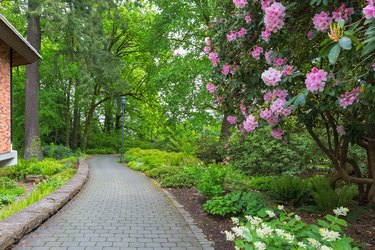
There is no doubting the ability of brick and stone pavers to add curb appeal to a property and charm to a backyard garden, and one of their best features is that they last virtually forever. Unfortunately, one of their few drawbacks is a significant one. Brick and stone are porous and provide an ideal habitat for mold and algae, which have a heyday during any period of wet weather.
Moss-covered brick walkways have a charm of their own, but moss can get slippery and hazardous, and for its part, mold is also potentially hazardous. While it's unlikely that of the thousands of mold species that grow outdoors the ones growing on your pavers are toxic, it's still possible, so removing mold from the pavers is a job you should approach with caution. If you developed the skill of masking up during the COVID-19 pandemic, here's another chance to put that skill to good use.
Video of the Day
Video of the Day
Power Washing Usually Does the Trick
If your brick pavers are securely embedded in the dirt and reinforced by each other to form a walkable surface, you can solve your mold, moss, and algae problem with a power washer. You don't need much power — an electric model that develops about 2,000 psi will do the job —and you don't want to overdo it anyway because high pressure could dislodge the pavers or chip them.
Nozzle tips for power washers are color coded according to the spray pattern, and for this job, you'll want to use the yellow (15-degree) or green (25-degree) tip. The white and black ones are too diffuse to do the job, and the red one (0 degrees) is overkill and will probably damage the pavers. Keep the tip a uniform 6 inches from the surface as you work and be sure to spray in the gaps to get rid of any black mold between the pavers.
Disinfect With Vinegar
Power washing doesn't always work. It can dislodge pavers that aren't securely embedded, and while it effectively dispatches moss and algae, which cling to the surface, it usually doesn't kill mold spores deep inside the pores. You need a disinfectant to do that, but bleach isn't the answer because it has a high surface tension that prevents it from soaking in. Vinegar is a better choice, and it's also safer to use and less likely to change the color of the pavers.
Fill a spray bottle with a 50-50 solution of distilled white vinegar and water (or use vinegar full strength for tough jobs) and spray the pavers carefully, avoiding surrounding plants. Do this on a dry day when the pavers are dry and let the solution soak into the pavers for at least an hour. Vinegar is weakly acidic and could affect the color of the pavers if you don't dilute it, so be sure to rinse well after the hour has elapsed.
Scrub Black Mold Off Pavers
Black spots on your pavers could be caused by a toxic mold species, such as Stachybotrys chartarum, or by another species, but since you can only find out by testing a sample in a lab, it's safest to treat all black mold stains as toxic. The best way to get rid of black mold is to scrub it off with detergent. If you have a large area to scrub, consider using a commercial mold-cleaning product designed for outdoor use.
Scrubbing to physically remove the mold may be a lot of work, but it's the best way to do it. Be sure to wear a mask while you're working and rinse the pavers thoroughly with a garden hose or a power washer when you're finished. Direct the runoff away from surrounding plants, which don't like ingesting detergent any more than you would.